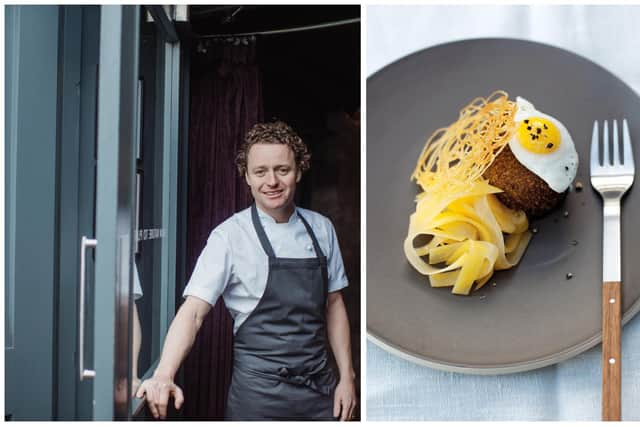Burns Night 2024: Edinburgh Michelin chef Tom Kitchin shares unique take on haggis, neeps and tatties
and live on Freeview channel 276
That time of year again when celebrations are held around the world in honour of Scotland’s greatest poet, Robert Burns, is approaching.
Burns Night is how we remember the life of the 18th-century bard and it falls on his birthday – January 25. The celebrations centre around the Burns supper, which traditionally consists of haggis, neeps and tatties.
Advertisement
Hide AdAdvertisement
Hide AdFor those looking to do something a little different this year, we asked Michelin star chef Tom Kitchin for his own take on Scotland’s national dish – and unsurprisingly, he cooked us up a real treat.


Here, the owner of acclaimed Edinburgh restaurants The Kitchin, Scran and Scallie and Kora talks us through his delicious recipe for haggis, pickled neeps and tatties.
“This is my re-invention of Scotland’s national dish. It’s very different from the hearty dish of haggis, puréed turnips (neeps) and potatoes traditionally served on Burn’s Night,” says Tom.
“Here the neeps are lightly pickled, the potatoes are fine and crispy, and portions of haggis are fried in breadcrumbs and topped with a quail’s egg for an elegant starter. You’ll need a mandoline to cut the potatoes,.”
Haggis, pickled neeps and tatties, by Tom Kitchin
Serves 4:
Ingredients:
For the haggis:
500g haggis
2 free-range egg yolks
100g plain flour
1 free-range egg, lightly beaten, for coating
100g breadcrumbs
vegetable oil, for deep-frying
4 quail’s eggs
For the neeps:
½ turnip, (neeps)
1 litre water
150g caster sugar
1 bay leaf
3 thyme sprigs
6 black peppercorns
1-2 garlic cloves
1 teaspoon salt
150ml white wine vinegar
For the tatties:
1 large potato
20ml clarified butter
sea salt
Method:
Advertisement
Hide AdAdvertisement
Hide AdFirst prepare the pickled neeps. Peel and thinly slice the turnip. Meanwhile, bring the rest of the ingredients to the boil in a saucepan. Remove from the heat, drop in the turnip slices and leave to infuse for 2–3 hours.
Meanwhile, cook the haggis. Bring a large pot of water to the boil. Wrap the haggis in foil and lower into the pan. When the water comes back to a simmer, turn the heat right down and leave to cook slowly for 2–3 hours.
Once cooked, remove the haggis from the pan, unwrap and slice open. Take it out of the bladder and put into a large bowl. Let cool slightly, then mix in the egg yolks. Turn the haggis out onto a sheet of cling film and shape into a roll, about 5 cm in diameter. Wrap in the cling film and refrigerate to firm up.
When ready, remove the pickled neeps from the liquid and cut into thin strips. Set aside.
Advertisement
Hide AdAdvertisement
Hide AdOnce chilled, unwrap the haggis and cut into 2.5 cm slices. Put the flour, beaten egg and breadcrumbs into 3 separate containers. Dip the haggis slices first in the flour to coat, then into the beaten egg, and finally into the breadcrumbs to coat all over; set aside.
For the tatties, peel the potato and cut into wafer-thin strips using a Japanese mandoline. Mix with a little clarified butter and salt. Heat a non-stick frying pan, add a quarter of the potato and shape gently into a 5cm circle. Fry gently until crispy, then carefully remove and keep warm while you cook the rest of the
potato in the same way to make 4 crispy potato cakes.
To fry the haggis cakes, heat the oil in a deep-fryer or other suitable deep, heavy pan to 180°C. Lower the haggis cakes into the hot oil and fry for 3–4 minutes until golden. Meanwhile, pile the neep strips onto warm plates. Remove the haggis from the pan, drain on kitchen paper and salt lightly.
Add a little more oil to the frying pan and fry the quail’s eggs for a minute or until the whites have set but the yolks are soft.
Place the haggis cakes alongside the neeps and top with the quail’s eggs. Place the crispy potato on the side and serve at once.
Comment Guidelines
National World encourages reader discussion on our stories. User feedback, insights and back-and-forth exchanges add a rich layer of context to reporting. Please review our Community Guidelines before commenting.
